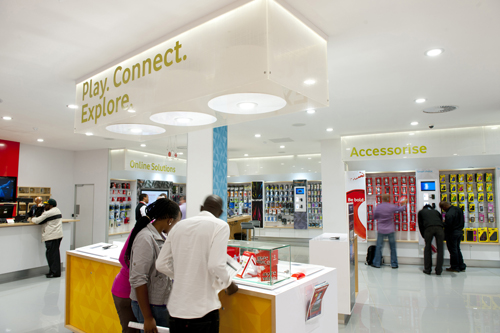
Behind Asia, Africa is the biggest mobile phone market in the world, and the fastest growing anywhere on the planet with the number of subscribers on the continent growing by almost 20 percent year-on-year for the last five years. Analysts estimate that by the end of 2012 there were more than 735 million subscribers across the continent, a figure that is the equivalent of a 65 percent penetration rate.
In South Africa mobile phone use has risen from 17 percent of adults in 2000, to 76 percent in 2010, with over 30 million people in the country now thought to use a mobile, more than those that own a radio, a television, a personal computer or indeed a landline phone.
Vodacom is a pan-African mobile telecommunications company and the lead cellular network in South Africa. Today the company provides GSM services to around 50 million customers in South Africa, Tanzania, Lesotho, Mozambique and the Democratic Republic of Congo. Aided by its release of a series of optimistic advertisements during the early stages of the democratic South Africa, Vodacom quickly grew into one of the leading networks in the country with an estimated market share that today stands at approximately 50 percent.
On 6 February 2013, Vodacom Group released its most recent trading statement for the quarter ending 31 December 2012. “This last quarter has been characterised by strong performance in data and our international operations, tempered by some challenges in our South African business,” commented Vodacom Group CEO, Shameel Joosub. “Group revenue expanded by 4.8 percent year-on-year and 7.1 percent quarter-on-quarter, while group data revenue increased by 23 percent and revenue from our international operations grew by 22 percent.”
During the quarter, active customer growth across the Group also remained positive with its international base growing 13 percent and its key South African base also increasing by 12 percent. While the number of customers increased in South Africa, voice revenue continued to be impacted by increased competition in what is today a softer economy. Such conditions have seen Vodacom make a much more concerted effort to focus its investment activities on maintaining its network leadership. This was perhaps best demonstrated in its commercial launch of its LTE service, the first of its kind in South Africa. At the time of writing, the company’s LTE coverage has now extended to reach Johannesburg, Pretoria, Durban and Cape Town, with 542 active sites and counting.
Vodacom’s quarterly results for South Africa show that in the three months to the end of December 2012, revenue increased by some 2.2 percent to R15.5 billion, driven primarily by the 27.2 percent growth in equipment revenue from smartphone and tablet sales. Meanwhile, when excluding the impact of regulated cuts in MTR’s, service revenue increased by 1.4 percent.
One of the factors that influenced these results was the company’s decision to take corrective action to improve its customer base and reduce the volume of one-off usage customers. As expected, this has resulted in higher churn and net disconnections during the quarter, however what it has also resulted in is a reduction in the company’s prepaid acquisition costs and improved profitability in its prepaid customer base.
Value offers and network investment saw the number of active customers in South Africa increase year-on-year by 11.7 percent to 30.6 million, while contract customer numbers increase by 6.0 percent to 5.9 million. This latter figure alone added almost double the net connections that Vodacom reported in each of the two previous quarters to approximately 120,000 customers.
At the heart of Vodacom’s integrated plans during the latter part of 2012 was its strategy of offering “much-more-for-more” (MM4M) and its “double your summer” promotions. Meanwhile, the company has continued to see a strong uptake in the integrated voice, SMS and data price plans that it first launched in July 2012, with almost a third of new mobile contract customers that signed on during the last quarter opting for these plans.
In what will come as little surprise given global trends, smartphones remained a key strategic growth driver for Vodacom in South Africa during the final few months of 2012, with active smartphones increasing 29.2 percent to 5.8 million devices. Smartphone net additions increased during the quarter, adding over 500,000 customers to Vodacom’s network, a figure largely supported by its working capital investment in handset financing.
Naturally the continued growth in smartphone uptake resulted in the company recording an increased in usage by over 36 percent to 138MB per smartphone customer per month. Indeed one of the more consistent trends that the company has recorded in recent times is that the appetite for data services amongst its customer base remains strong, with active data customers increasing to 13.8 million, representing over 45 percent of its customer base.
Another important differentiator for Vodacom continues to be its commitment to network investment. One such investment has seen the company make further strides in improving the speed and coverage of its 3G network, adding 317 base stations in the quarter to take its total to 5,855. In addition, Vodacom continues to invest in increasing the capacity of its voice network to support higher customer usage.
Written by Will Daynes, research by Candice Nice



 VodacomSA-Africa.Telecoms-Mar13-Bro-s.pdf
VodacomSA-Africa.Telecoms-Mar13-Bro-s.pdf









